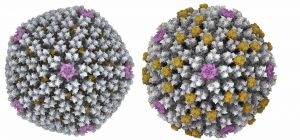In collaboration with the Pasteur Institute in France, the researchers analysed the adenovirus genome evolution and found that these structural similarities are due to an ancestral duplication of the LH3 gene and a subsequent differential evolution. "These results indicate that a common ancestor of reptilian and mammalian adenoviruses acquired the LH3 gene from bacteria or bacteriophages, probably when they met in the same environment (for example, the intestine of an animal)" indicates Gabriela Condezo, researcher from the CNB-CSIC that participates in the study. “Later, the gene was duplicated, and each of the two copies evolved independently, until they reached what we see today in human adenoviruses. One of the copies changed drastically and kept only the small part that allows the protein to anchor to the capsid, becoming protein IX. The other copy lost the anchoring part and ceased to be part of the viral particle, becoming nothing less than an oncoprotein ”For Roberto Marabini, researcher at the UAM, “these data allow us to see a small part of the evolutionary history of adenoviruses, which probably changed as the host organisms also evolved. Furthermore, they show us how viruses reuse and transform genes from other organisms, generating new functions for proteins during evolution”. Knowledge on the structure and function of non-human adenoviruses is relevant in the global health context, since they are pathogens for animals with economic (birds, ruminants) or ecological (reptiles, amphibians) importance. In addition, they have potential as therapeutic tools alternative to human adenoviruses , for which a large part of the general population already has an immune response, making them less effective as drugs. This is why, for example, some of the SARS-CoV-2 vaccines use a chimpanzee adenovirus instead of a human one to generate an efficient immune response against coronavirus proteins.
More information:
Near Atomic Structure of an Atadenovirus Reveals a Conserved Capsid-Binding Motif and Intergenera Variations in Cementing Proteins. Marabini R, Condezo GN, Krupovi M., Menéndez-Conejero R, Gómez-Blanco J, and San Martín C. Sci Adv 2021, 7 (14) doi: 10.1126/sciadv.abe6008.






